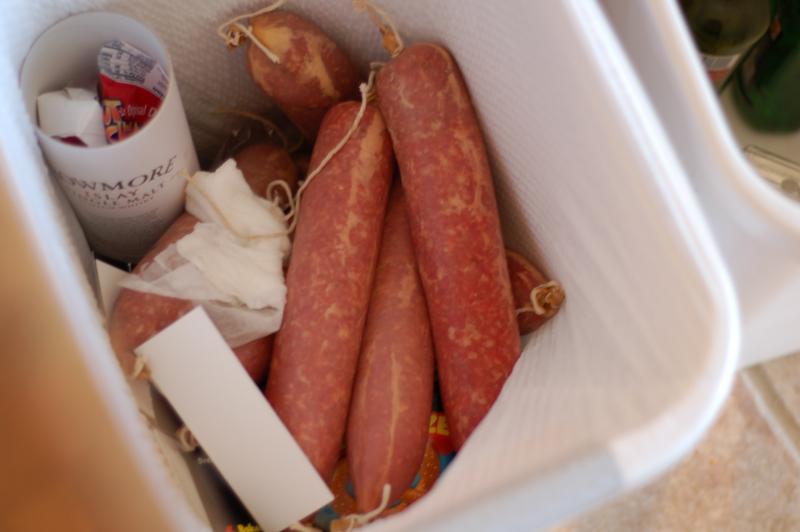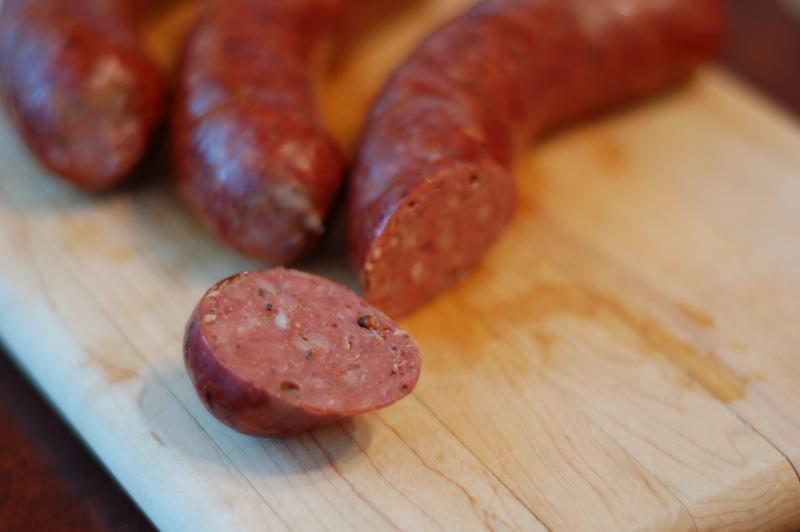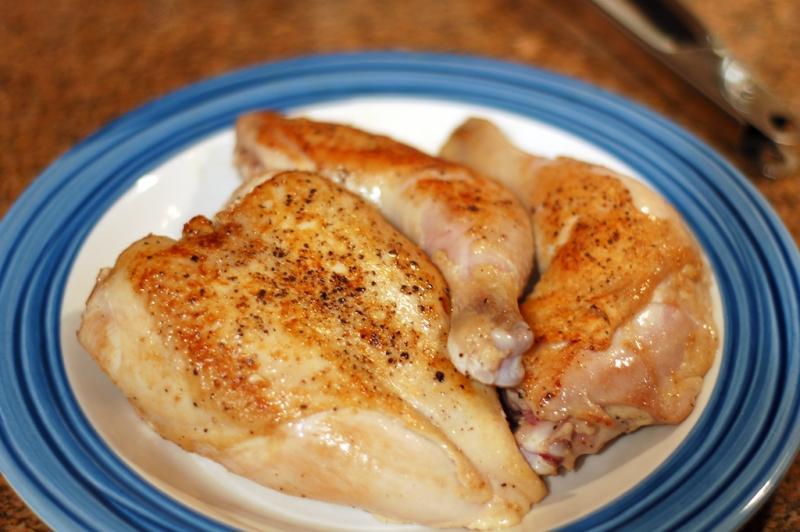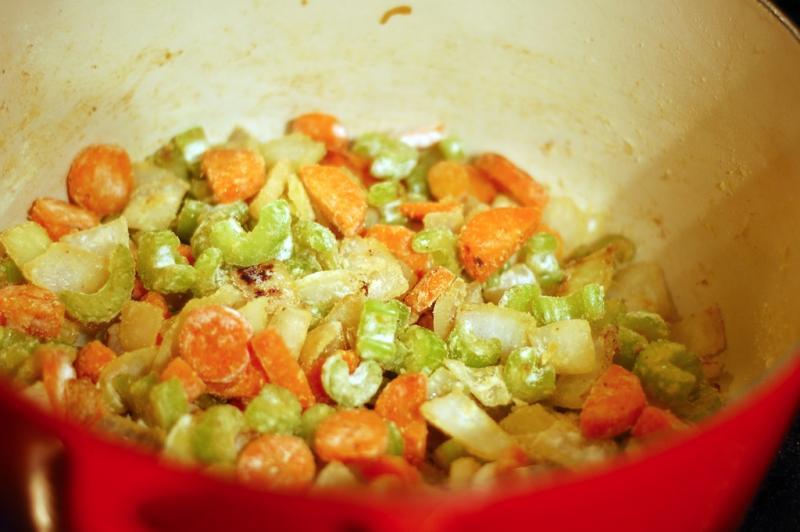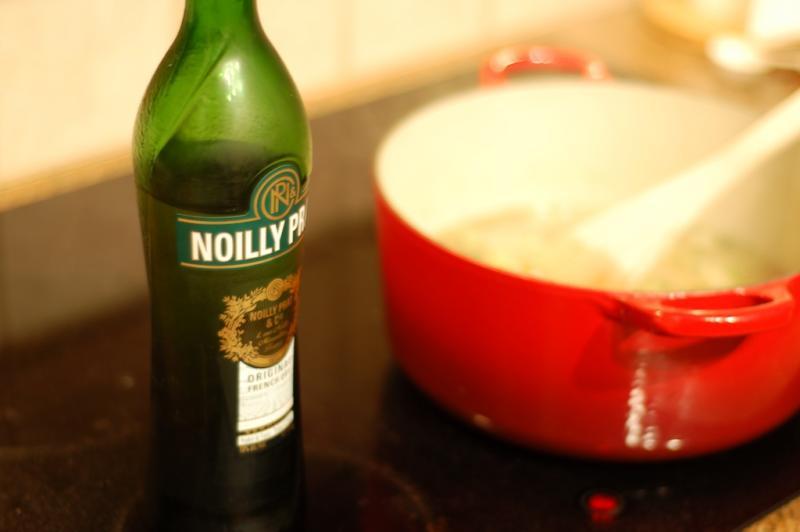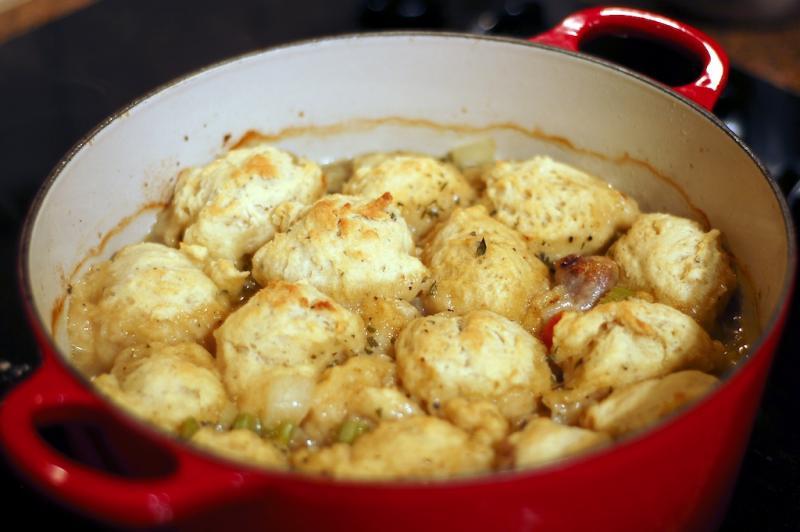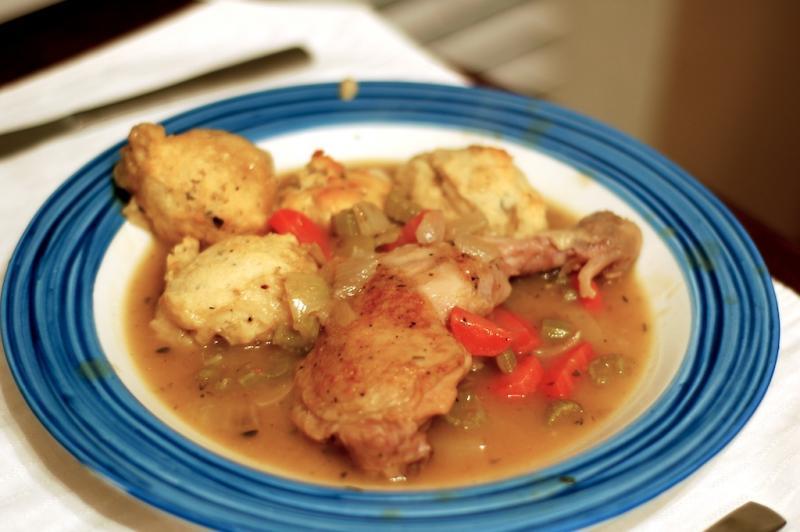-
Posts
10,190 -
Joined
-
Last visited
Content Type
Profiles
Forums
Store
Help Articles
Everything posted by Chris Hennes
-
No, just the steady, unfalling pH. Setting aside flavor considerations, I'm concerned about botulism growth when the pH is above 5.3 or so. This was the T-SPX slow-fermenting culture, which spent three days fermenting at 90% humidity and 22°C. Given the amount of sugar I included (0.4%) I would have expected the pH to drop to below 5.3 in that time: instead, it didn't drop at all, even given a full week. While I wasn't counting on the low pH as the sole safety measure (the salami also contained salt and cure #2), I'm not going to risk botulism AND poor flavor, as well as occupying my curing chamber for the next two months. Better to start over and get it right, in my opinion.
-
Of late I've become much more interested in dry-curing my own salami. I make a lot of fresh sausage already, but dry curing is a great and unique challenge, and well-made salami is one of my favorite foods. I think I got hooked for good after making the peperone out of the Ruhlman and Polcyn book (I wrote about that over here). I had made the Sopresatta first, and it was good, but that peperone was AMAZING. I have quite a few books on charcuterie, including the Marianski book dedicated to dry-curing. I do my curing in a wine fridge, I've got a smoker set up, I use the Northern Tool grinder, and a cylinder stuffer with a 5lb capacity. Hell, I've even got an old slicer I got off eBay. I should be totally good to go. But sometimes, you just have one of those days... This morning I threw away twelve pounds of salami that I started curing last weekend. The problem? I killed the starter. Somehow. Dunno what I did, but when my new pH test strips arrived (thanks for the recommendation, Dougal, they worked great), to my surprise the pH had not dropped one bit. But, it turns out the three-year-old bottle of distilled water I was using to make the meat slurry had a pH of 5.5!!! So, this topic is for advice, assistance, and general commiseration about how everything woulda been just fine if only... Advice point 1: when that package of starter culture says "use no less than 1/4 of this package," they have a reason. Because instead, I foolishly followed the Marianski recipe to the letter and included only 0.6 grams of starter. The results speak for themselves. Hey, maybe that's not what did it, maybe there was something else wrong. But $45 in trashed meat later and I'm seriously regretting my decision to skimp on the starter.
-
Alright! Me and my +1 are in, and I will be bringing along a rather large selection of homemade charcuterie if I can work out the logistics of getting it there. And you can sign us up for dish-detail again as well, I like to get in the way in the kitchen.
-
I'd be very curious to know if you actually have an iodine deficiency at this point, after being directly injected with it (albeit in its radioactive form).
-
Of course I want another meter, digital readouts are far more high-tech-looking than little paper strips! Next I'll be looking for a data logger so I can make plots of pH versus time... and then comes the PowerPoint! Alright, alright, I'll order up some of these strips and give them a go... thanks for the assist.
-
First, regarding the meters: you're right, the one I link to above (and most of those available on Amazon.com) turn out to be intended for measuring the pH of liquids: a meat slurry is not quite liquid, so I'm sure I'd be wearing through the sensor much faster than the manufacturers intended. Plus, making the slurry is annoying. So I've switched modes to looking at sensors designed to test the pH of soils. For example, the FieldScout SoilStik pH Meter looks promising. From the writeup: I think this sounds like a promising route, though the price is getting a bit high. Also, as you note, calibration is important, and needs to be done relatively frequently: there are kits available to help with this, but of course they will increase the total cost of ownership. My first concern with the pH is safety: as I make more and more dry-cured salami and branch out into different strains of bacteria, and as I shared them with more and more people, I want to make sure I'm not going to give anyone botulism. So on that count, getting the pH down into the vicinity of 5 is important, and I'd really like to be able to measure this with some degree of confidence. Is it worth the $150 that sensor I link to above costs? I don't know. But I only have high-range and low-range test strips: nothing that really allows me to confidently distinguish between a pH of 4.5 and a pH of 5.5. Beyond just safety, the engineer in me simply wants to know the number and record it in my notebook .
-
I'm considering buying an electronic pH meter: does anyone have one they can recommend? There are lots of them available at Amazon.com, in particular the HM Digital PH-200 Waterproof pH Meter seems promising for use in the kitchen. I've been making a lot of dry-cured salami recently, so on my last order from Butcher and Packer I picked up a roll of low-range pH test strips. These are the kind where you make a slurry of a test sample of the sausage and dip the strip in: the strip changes, color and you match it up to the color on the little card that comes with the kit. The problem I am having is that a) the gradations on the test card are too large and too subtle (the upper range is a color swatch at 4.8 and then one at 5.2, and they both look pretty similar when it comes to comparing the little strips), and b) the appropriate pH of 4.9 (according to Ruhlman) is perilously close to maxing out the upper range of these strips, since it will appear to be somewhere between the last two color swatches.
-
This year I'm putting in: Purple perfect German Head Eva Purple Ball Orange Strawberry Giant Belgium Dorothy's Green Druzba I'm not sure how the Giant Belgium snuck their way into my order: most of the other varieties are relatively small and should mature in around 80 days. Tomatoes stop setting fruit here come mid-summer since it's too hot for them, so I'm experimenting with these this year to see what grows best for me. They were all chosen for flavor (and to give a variety of colors), I got them out of 100 Heirloom Tomatoes for the American Garden.
-
Right, the glue is going to be a problem at those high temperatures. Frankly I wouldn't worry about "sterilizing" a wooden block: as I mentioned above, wood is pretty good about killing bacteria all on its own simply by absorbing the water out of their cells. And once you start letting the interior of those slots get wet and build up a high-moisture environment you are actually creating a very nice habitat for various sorts of bacteria unless you have a good way of drying them back out. That's the reason you should be sure your knives are completely dry before storing them in a slot-type rack.
-
Repeatedly letting wood absorb a lot of water and then dry out will have a tendency to cause the wood to crack, yes. That said, I think you probably do this infrequently enough that it doesn't really matter. You will want to make sure to dry the interior thoroughly to prevent mold from growing in the slots, however. From a food safety standpoint wood is a mixed bag: it's difficult to completely sanitize yourself because it is so porous, but it tends to kill bacteria on its own by absorbing the water from their cells (see the fairly extensive research on wood cutting boards for more details).
-
I got a load of wild duck breasts from one of my wife's coworkers: they were skin off, since they were cut out in the field, so I couldn't really think of anything to do with them besides sausage. Starting from a recipe in Bruce Aidells' Complete Sausage Book I made these: I made a few rather major modifications, however, so I can't really comment on the quality of the recipe. First, he calls for 1 part dark meat and 1 part duck trim and fat, plus a small amount of bacon. I used 2 parts duck breast to 1 part pork shoulder and 1 part pork belly fat, and no bacon. He also calls for what seems like a lot of liquid to me, a half cup water and a half cup Gran Marnier to five pounds meat. I cut that in half out of concern that the liquor would be too overt, but I think in retrospect that was not necessary, it's all but undetectable in the final product. Finally, I hot smoked the finished sausages for an hour or so over apple, because smoke and duck are a great combination and I had omitted the bacon. Wow, the finished sausage is excellent: in particular, the gaminess of the wild duck serves as an excellent flavor note on the finish without being overwhelming.
-

Curing and Cooking with Ruhlman & Polcyn's "Charcuterie" (Part 6)
Chris Hennes replied to a topic in Cooking
Yeah, I went with an Aidells recipe instead (sort of... maybe more like "inspired by Aidells"). -

Curing and Cooking with Ruhlman & Polcyn's "Charcuterie" (Part 6)
Chris Hennes replied to a topic in Cooking
Has anyone tried the Duck, Sage, and Roasted Garlic sausage? I was going to make it today, but Holy Sage, Batman. I only bought one package, without paying any attention to how much the recipe called for, and of course, it looks like I actually need three. Which seems like a LOT of sage. Time for plan B, I think. -
I'm in for Ann Arbor, if my schedule will accommodate. I have a conference the first week of August so probably can't make the weekend of July31/Aug1.
-
According to this AP story (they have a picture, too) Heinz is introducing a new type of ketchup packet to making dipping easier on the go. From the article: What do you think? I dunno if I need three times as much ketchup, for one thing...
-
We're happy to announce that, after successful training and three-month's probation, Linda Kowalcky (LindaK) has joined our hosting team! Society volunteers donate their time to create topics, keep forums organized, support members, and make the eG Forums the vibrant place it is. Please join us in welcoming and thanking Linda by sending her a PM. Thanks, Linda!
-
I'm currently enjoying a "Say Goodnight Gracie" made with Fee Bros. Lemon Bitters (alas, no rhubarb in the arsenal at the moment), and the resulting drink is quite good. The flavor of the Clement comes through loud and clear, I think the drink was an excellent suggestion for highlighting this rum. Thanks, Katie!
-
We just finally got the Clement Rhum Agricole (DOC) here in Oklahoma, so of course I was forced to buy a bottle. Now what can I make with the stuff? The suggestion upthread of a rum and coke is... out of the question considering the price of the stuff. Cocktail suggestions? Or should I be drinking this straight?
-
A half teaspoon sounds like a LOT of orange flower water to me: I wonder if the brand you are using is not as potent as the stuff I have here. I fear that if I added any quantity above a drop or two the whole thing would taste like orange perfume.
-
On the far right-hand side of your photo in the upper region of the coriander there are small streaks of orange: these seem out of place to me. Is that just a photographic artifact?
-
Alright, I took some of the suggestions here and tweaked my normal method last night. Here goes... First off, I like to brown the chicken parts to render some schmaltz and get that roasted flavor: Second, I love celery, so in go three stalks, along with two carrots and a yellow onion, all chopped coarse, plust a few tablespoons of butter to complement the schmaltz: Once the vegetables have softened a bit I add a few tablespoons of flour and let it soak up the fat and toast a little: Next, a quart of homemade chicken stock (I used a quart I had on hand and supplemented it earlier by simmering the leftover parts of this chicken in it), plus my "secret" ingredient, Noilly Prat, which I prefer here over a white wine or other acid: Next up my standard dumpling recipe: 2 cups flour, 1 cup hot milk, 3 tablespoons melted butter, 1 tablespoon baking powder, salt, pepper, and this time, some thyme and sage, since that's what I had on hand. I steamed them lid on for 15 minutes, and then into a 450°F oven for another ten minutes lid off to get a bit of browning: And finally, my super-fancy plating (obviously, I couldn't even be bothered to wipe the rim of the plate...): I agree with Chris above: even though my mom made Chicken and Dumplings with steamed dumplings, giving them that bit of crispness at the end is a nice addition. My wife agrees, so I think this is a permanent change to my C&F recipe.
-

Curing and Cooking with Ruhlman & Polcyn's "Charcuterie" (Part 6)
Chris Hennes replied to a topic in Cooking
Indeed, the definition is stunning: very nice work. Any mold formation? -
How are you determining the cooking time? For me the biggest difference between a cake and a cupcake is just a change to the time and temp.
-
Honestly Chris, I'd leave out the chicken before I'd leave out the dumplings: they are my favorite part, purely on a taste basis. They absorb flavor from the cooking liquid, beside bringing plenty of their own (despite sounding like a recipe for cardboard, flour, milk, butter and baking soda have plenty of taste).
-
I make mine with 2 cups flour, 1 cup hot milk, 4 tablespoons butter (melted), 1 tablespoon of baking soda, and salt. They are light enough to float, but just barely.


